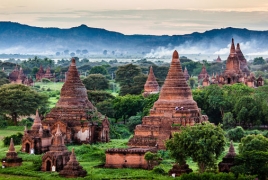 Bagan, city of templesDamaged by people, time and nature Thousands of temples are spread across the plains of Bagan, Myanmar (Burma), serving as a symbol of the religious devotion of the country’s people and their rulers over the centuries. They combine to form one of the richest archaeological sites in Asia and provide a view you will not see anywhere in the world. The entry fee of 25,000 25000 Myanmar Kyat (about $20) gives tourists five days to explore the territory officially called the Bagan Archaeological Zone. PanARMENIAN.Net - The ancient city is located on the banks of the Ayeyarwady (Irrawaddy) River, in the Mandalay Region of Myanmar. It lies in the middle of the "dry zone" of Myanmar. Unlike the coastal regions of the country which receive annual monsoon rainfalls, the dry zone gets little precipitation as it is sheltered from the rain by the Rakhine Yoma mountain range in the west. From the 9th to 13th century, Bagan was the capital of the Kingdom of Pagan, and the political, economic and cultural center of the Pagan Empire. Monks and scholars from India, Ceylon and the Khmer Empire came to Bagan to study prosody, phonology, grammar, astrology, alchemy, medicine, and law. During the kingdom's height (11th-13th century), the wealthy Pagan rulers ordered to build thousands of temples in the Bagan plains. As a result, around 10,000 Buddhist temples, pagodas and monasteries were built, of which over 2200 construction survived to the present day. The last ruler of Bagan, King Narathihapati (1255-1287), was also a builder and was responsible for the construction of Bagan's last major religious project, the Mingala-zeidi. When the Mongol armies came into the area, however, he refused to pay tribute and offered serious resistance. He reportedly tore down over 6,000 temples and pagodas to reinforce the city walls. This destruction of an important part of its heritage, however, was to no avail, historians say. By 1287 Narathihapati (also known in Bagan history as Tayok-pye-min: 'the King who ran away from the Chinese') had indeed run away. He was poisoned by his son, the ruler of Pyay (Prome) a kingdom south of Bagan on the Ayeyarwady. The invading armies of Kublai Khan finally completed Bagan's demise. The Mongol conquest was complete, although perhaps far more destruction had come from the futile defensive measures than from the Mongol invasion itself. With the end its golden age, Bagan's population was reduced to a village that remained amongst the ruins of the once larger city. New religious monuments still went up to the mid-15th century but afterward, temple construction slowed to a trickle with less than 200 temples built between the 15th and 20th centuries. Situated in an earthquake-prone area, Bagan suffered from many earthquakes over the ages, with over 400 recorded earthquakes between 1904 and 1975. In the 1990s, the government made an effort to restore many of the damaged buildings, but the failure to retain the original architectural styles and the use of modern materials drew widespread condemnation from art historians worldwide. Bagan had to pay the price of the government's irresponsible act when UNESCO rejected the city as a designation for World Heritage Site due to the ‘un-historic way’ the temples were restored, although the government believes that the ancient capital's hundreds of unrestored temples and large corpus of stone inscriptions were more than sufficient to win the designation. Bagan is one of Myanmar’s main tourist destinations. The majority of over 300,000 international tourists to the country are believed to have also visited the site. On August 24, 2016, a major earthquake hit central Myanmar and damaged almost 400 temples in Bagan. Today, visitors are prohibited from entering 33 damaged temples. Lusine Mkrtumova / PanARMENIAN.Net How collection of horned creatures turned into museum New York’s first female crime boss World’s largest boneyard An Italian photojournalist’s journey through the pandemic Quarantine in metropoles Town without newborns and dead Nine months in the Pacific |